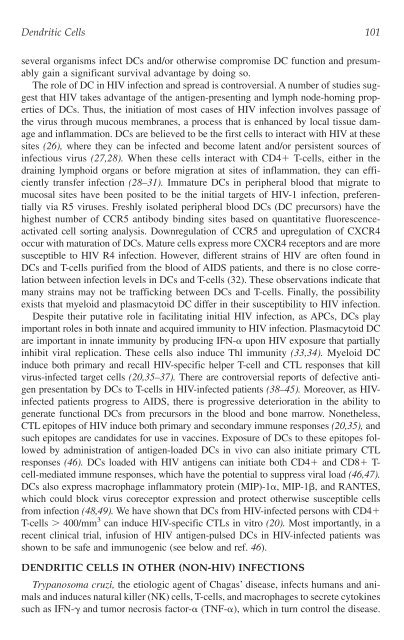Immunotherapy for Infectious Diseases
Immunotherapy for Infectious Diseases
Immunotherapy for Infectious Diseases
You also want an ePaper? Increase the reach of your titles
YUMPU automatically turns print PDFs into web optimized ePapers that Google loves.
Dendritic Cells 101<br />
several organisms infect DCs and/or otherwise compromise DC function and presumably<br />
gain a significant survival advantage by doing so.<br />
The role of DC in HIV infection and spread is controversial. A number of studies suggest<br />
that HIV takes advantage of the antigen-presenting and lymph node-homing properties<br />
of DCs. Thus, the initiation of most cases of HIV infection involves passage of<br />
the virus through mucous membranes, a process that is enhanced by local tissue damage<br />
and inflammation. DCs are believed to be the first cells to interact with HIV at these<br />
sites (26), where they can be infected and become latent and/or persistent sources of<br />
infectious virus (27,28). When these cells interact with CD4� T-cells, either in the<br />
draining lymphoid organs or be<strong>for</strong>e migration at sites of inflammation, they can efficiently<br />
transfer infection (28–31). Immature DCs in peripheral blood that migrate to<br />
mucosal sites have been posited to be the initial targets of HIV-1 infection, preferentially<br />
via R5 viruses. Freshly isolated peripheral blood DCs (DC precursors) have the<br />
highest number of CCR5 antibody binding sites based on quantitative fluorescenceactivated<br />
cell sorting analysis. Downregulation of CCR5 and upregulation of CXCR4<br />
occur with maturation of DCs. Mature cells express more CXCR4 receptors and are more<br />
susceptible to HIV R4 infection. However, different strains of HIV are often found in<br />
DCs and T-cells purified from the blood of AIDS patients, and there is no close correlation<br />
between infection levels in DCs and T-cells (32). These observations indicate that<br />
many strains may not be trafficking between DCs and T-cells. Finally, the possibility<br />
exists that myeloid and plasmacytoid DC differ in their susceptibility to HIV infection.<br />
Despite their putative role in facilitating initial HIV infection, as APCs, DCs play<br />
important roles in both innate and acquired immunity to HIV infection. Plasmacytoid DC<br />
are important in innate immunity by producing IFN-� upon HIV exposure that partially<br />
inhibit viral replication. These cells also induce Thl immunity (33,34). Myeloid DC<br />
induce both primary and recall HIV-specific helper T-cell and CTL responses that kill<br />
virus-infected target cells (20,35–37). There are controversial reports of defective antigen<br />
presentation by DCs to T-cells in HIV-infected patients (38–45). Moreover, as HIVinfected<br />
patients progress to AIDS, there is progressive deterioration in the ability to<br />
generate functional DCs from precursors in the blood and bone marrow. Nonetheless,<br />
CTL epitopes of HIV induce both primary and secondary immune responses (20,35), and<br />
such epitopes are candidates <strong>for</strong> use in vaccines. Exposure of DCs to these epitopes followed<br />
by administration of antigen-loaded DCs in vivo can also initiate primary CTL<br />
responses (46). DCs loaded with HIV antigens can initiate both CD4� and CD8� Tcell-mediated<br />
immune responses, which have the potential to suppress viral load (46,47).<br />
DCs also express macrophage inflammatory protein (MIP)-1�, MIP-1�, and RANTES,<br />
which could block virus coreceptor expression and protect otherwise susceptible cells<br />
from infection (48,49). We have shown that DCs from HIV-infected persons with CD4�<br />
T-cells � 400/mm 3 can induce HIV-specific CTLs in vitro (20). Most importantly, in a<br />
recent clinical trial, infusion of HIV antigen-pulsed DCs in HIV-infected patients was<br />
shown to be safe and immunogenic (see below and ref. 46).<br />
DENDRITIC CELLS IN OTHER (NON-HIV) INFECTIONS<br />
Trypanosoma cruzi, the etiologic agent of Chagas’ disease, infects humans and animals<br />
and induces natural killer (NK) cells, T-cells, and macrophages to secrete cytokines<br />
such as IFN-� and tumor necrosis factor-� (TNF-�), which in turn control the disease.


